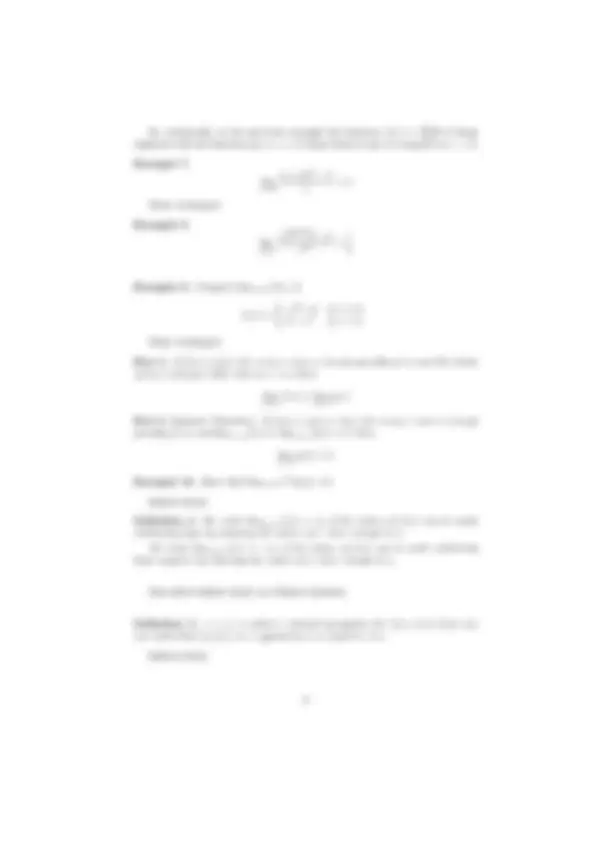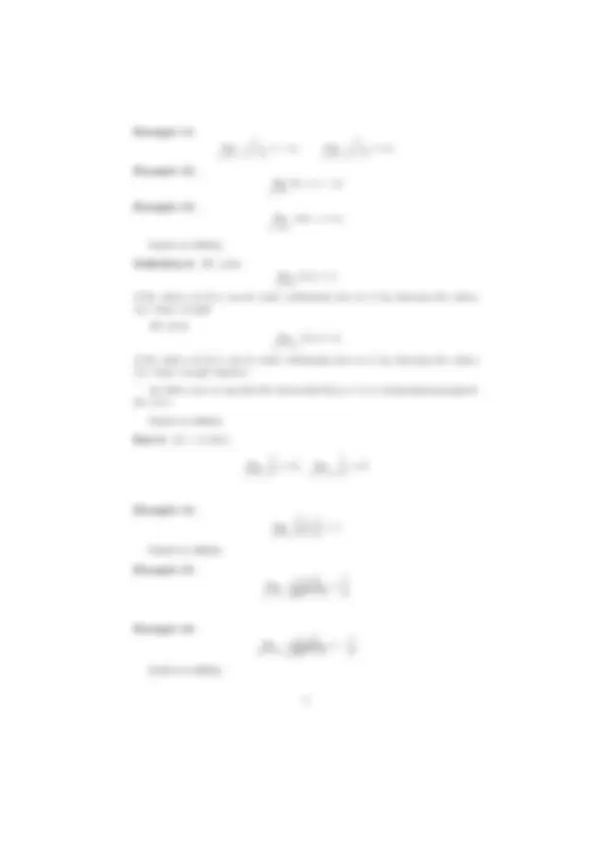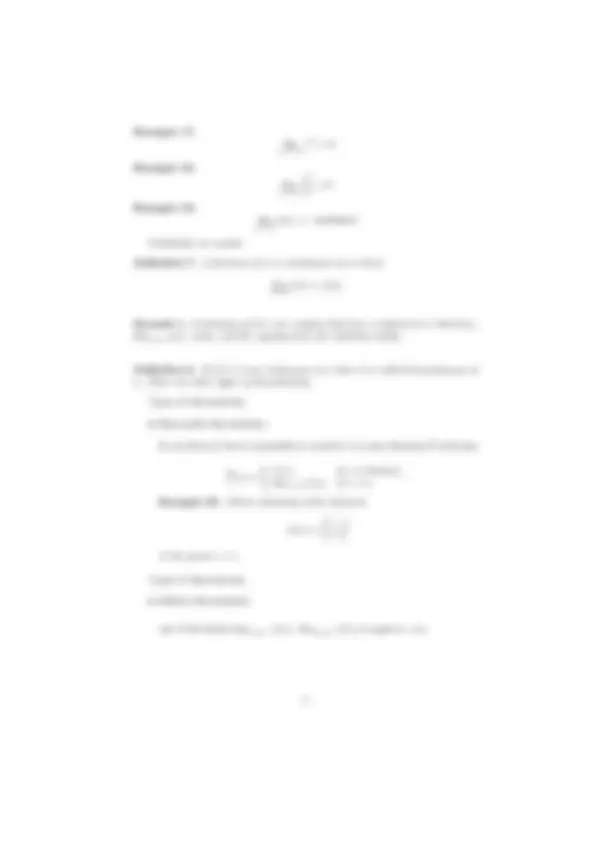





Study with the several resources on Docsity

Earn points by helping other students or get them with a premium plan


Prepare for your exams
Study with the several resources on Docsity

Earn points to download
Earn points by helping other students or get them with a premium plan
Community
Ask the community for help and clear up your study doubts
Discover the best universities in your country according to Docsity users
Free resources
Download our free guides on studying techniques, anxiety management strategies, and thesis advice from Docsity tutors
Definitions and computational methods for limits of functions. It covers both informal and formal definitions, as well as techniques for computing limits of sums, differences, products, quotients, and functions that are continuous or discontinuous at a point. The document also discusses one-sided limits, infinite limits, and limits at infinity.
Typology: Lecture notes
1 / 7

This page cannot be seen from the preview
Don't miss anything!




Formal vs Informal Definition of a Limit
Definition 1 (Informal definition). The limit of a function f (x), as x ap- proaches a ∈ R, is L ∈ R, and we write
lim x→a f (x) = L
if the values of f (x) can be made arbitrarily close to L by choosing the values of x close enough to a.
Definition 2 (Formal definition). We write
lim x→a f (x) = L
if for any ε > 0 there exists δ > 0 such that
|x − a| < δ implies |f (x) − L| < ε.
Computing limits by definition To prove that lim x→a f (x) = L
consider a game in which your opponent makes a move by giving you a number ε > 0 and you respond by producing a number δ > 0 (which depends on ε) such that |x − a| < δ implies |f (x) − L| < ε
Example 1. Prove that lim x→ 1
Solution. We have f (x) = 1 for every x. Suppose ε > 0 is given and we have to find δ > 0 such that |x − 1 | < δ implies | 1 − 1 | < ε. In this case any positive number δ works since | 1 − 1 | = 0 < ε. So, choose δ = 1 - this is our response to any given ε.
Computing limits by definition
Example 2. Prove that lim x→ 1
x = 1
Example 3. Prove that lim x→ 0 x^3 = 0
One-sided limits Similarly, one can defined one-sided limits as follows
Definition 3. We write lim x→a−^
f (x) = L
if the values of f (x) can be made arbitrarily close to L by choosing the values of x close enough to a and less than a. We write lim x→a+^
f (x) = L
if the values of f (x) can be made arbitrarily close to L by choosing the values of x close enough to a and greater than a.
One-sided limits
Fact 1. lim x→a f (x) = L
if and only if
lim x→a−^
f (x) = L and lim x→a+^
f (x) = L.
Example 4.
lim x→ 0
|x| x
= undefined
Basic techniques
Fact 2. The limit of a sum, difference, or product is equal to the sum, difference, or product of the limits provided all the limits involved exist. The limit of a quotient is the quotient of the limits provided that the limit of the denominator is not 0.
Example 5 (Positive example).
lim x→ 0
x^3 + 2x^2 − 1 1 − 3 x
Example 6 (Negative example).
lim x→ 2
x^2 − 4 x − 2
Basic techniques
Fact 3. If f (x) = g(x) for every x near a (but not equal to a) then
lim x→a f (x) = lim x→a g(x)
provided both exist.
Example 11.
lim x→ 1 −
x − 1
= −∞ lim x→ 1 +
x − 1
Example 12. lim x→ 0 +^
ln x = −∞
Example 13. lim x→ π 2 −
tan x = ∞
Limits at infinity
Definition 6. We write lim x→∞ f (x) = L
if the values of f (x) can be made arbitrarily close to L by choosing the values of x large enough.
We write lim x→−∞ f (x) = L
if the values of f (x) can be made arbitrarily close to L by choosing the values of x large enough negative.
In either case we say that the horizontal line y = L is a horizontal asymptote for f (x).
Limits at infinity
Fact 6. If r > 0 then
lim x→∞
xr^
= 0, lim x→−∞
xr^
Example 14.
lim x→∞
x^2 − 1 x^2 + 1
Limits at infinity
Example 15.
lim x→∞
x + 2 √ 9 x^2 + 1
Example 16.
lim x→−∞
x + 2 √ 9 x^2 + 1
Limits at infinity
Example 17. lim x→−∞ ex^ = 0
Example 18.
lim x→∞
x^2 ex^
Example 19. lim x→∞ sin x = undefined
Continuity at a point
Definition 7. A function f (x) is continuous at a ∈ R if
lim x→a f (x) = f (a)
Remark 1. Continuity of f (x) at a implies that f (a) is defined (a ∈ Dom(f )), limx→a f (x) exists, and the equality from the definition holds.
Definition 8. If f (x) is not continuous at a then it is called discontinuous at a. There are three types of discontinuity.
Types of discontinuity
if a /∈ Dom(f ) but it is possible to extend f to a new function f such that
f (x) =
f (x), if x ∈ Dom(f ), limx→a f (x), if x = a.
Example 20. Check continuity of the function
f (x) =
x^2 − 1 x − 1
at the point x = 1.
Types of discontinuity
one of the limits limx→a− f (x), limx→a+ f (x) is equal to ±∞.
Example 24. Find the values of the parameter c which make the function continuous everywhere
f (x) =
cx^2 + 2x if x < 2 , x^3 − cx if x > 2 ,
Continuous functions
Fact 9 (Composition). If f (x) is continuous at b and limx→a g(x) = b, then
lim x→a f (g(x)) = f
lim x→a g(x)
Example 25.
lim x→ 2 tan−^1
x^2 − 4 3 x^2 − 6 x
= tan−^1
Intermediate Value Theorem
Theorem 1. If f (x) is continuous on the closed interval [a, b] and N ∈ R is between f (a) and f (b), where f (a) ̸= f (b), then there exists c ∈ [a, b] such that f (c) = N.
Example 26. Show that there is a root of the equation x^4 + x − 3 = 0 on the interval (1, 2).